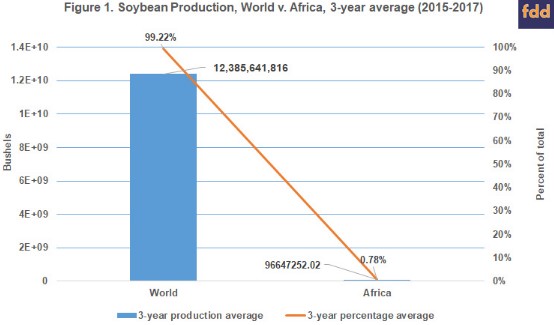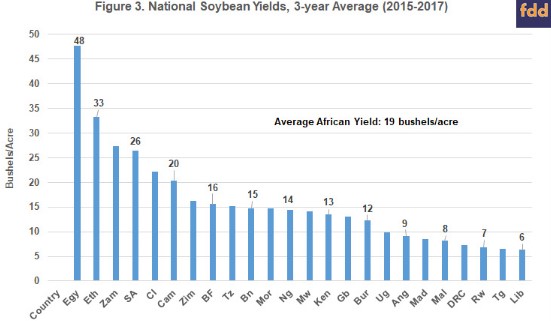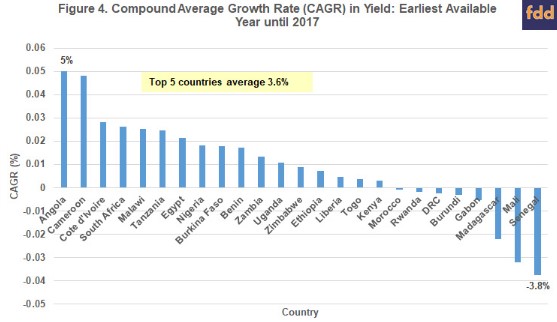By Margaret Cornelius and Peter Goldsmith
African producers supply less than 1% of the world’s soybeans (Figure 1). Worldwide production of soybean has grown at a compound annual growth rate (CAGR) of 4.68% since 1961, while African production levels are rising 48% faster at a rate of 6.84% per year. Both world and Africa’s growth in production mostly result from an increase in soybean acres planted and not from yield. South Africa, Nigeria, and Zambia are the top three soybean producers on the African continent. South Africa’s 3-year (2015-2017) production average was 38.3 million bushels, which is 39% of the African continent’s production (Figure 2). Nigeria’s 3-year production average was 23.7 million bushels, which is 25% of the continent’s production. Zambia’s 3-year average was 10.4 million bushels, which is 11% of the continent’s production. The other 21 countries, where data are available, together produced 25% of Africa’s total soybean production. The average national production is 4,026,969 bushels, and the smallest producer is Madagascar, whose three-year production average is 1,470 bushels. Annual production remains below 1,000,000 bushels for 15 of the 24 countries for which data exists.


Global average yield per hectare is 41 bushels per acre, while African producers produce less than half the yield at 19 bushels per acre (Figure 3). Egypt, using irrigation, leads all of Africa in terms of average soybean yield at 48 bushels per acre, while Ethiopia and Zambia, the number two and three yield leaders average 33 and 27 bushels per acre, respectively. South Africa, Africa’s soybean leader, averages 26 bushels per acre. Yields remain below 15 bushels per acre for 15 of the 24 African countries for which data exist.

The 24 African countries for which official yield data exist have an average CAGR in yield of 0.9%, while the top five producing countries have an average CAGR of 2.0%. Globally average production per hectare has risen at a rate of 1.64% since 1961. The five leading countries in Africa produce 86% of the region’s soybean. Forecasted addition supply from these leaders by 2030 would only see an increase in supply of a little over 18 million bushels, or less than .15% of current global production. Angola has the highest CAGR for soybean yield at 5.3% per year. Cameroon and Cote d’Ivoire follow at 4.92% and 2.88%, respectively (Figure 4). These three countries, though achieving relatively high annual growth rates in yield, are advancing from a low base producing less than 1.4 million bushels combined. South African, Nigeria and Zambia, the regions leaders in terms of total production achieve CAGR’s of 2.6%, 1.8%, and 1.3 % respectively, thus still maintain low productivity growth.

In conclusion, Africa remains a minor player within the global soybean production scene. Levels of production are low, as are growth rates in yield. Total soybean supply presents a minimal effect on global markets. Not only are levels of production low, but growth rates in yield also show slow growth. Total production in the region though is rising faster than the world as a whole, but that increase originates from a very low base of production. Forecasts using currently available data portend a continent where domestic demand for soybean will continue to outstrip domestically produced supplies in the medium term, and imports will remain an important feature for meeting Africa’s soybean, soybean meal, and soybean oil needs.
Source : farmdocdaily